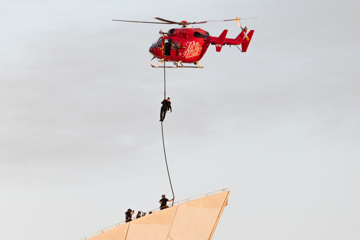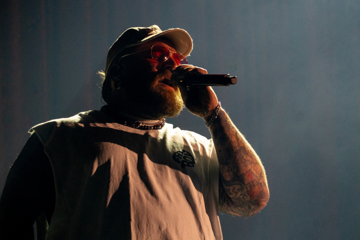1 Giant Leap: Leaping Beauty.

They Might Be Giants.
1 Giant Leap is in stores now.
The Queen Mother's funeral procession made its way across London a few kilometres from where Duncan Bridgeman sits finishing off his breakfast. And while the artist, producer and multi-instrumentalist isn't a royalist he does note that such a event "makes everybody think a little about dying and that however famous somebody might be, they are just human. And we're all gone very soon. Death is inevitable," he chuckles, "it's just a matter of how long we can string life out for before we eventually get there."
Celebrating life becomes important then. And that's what Bridgeman is doing with his partner, musician, film director, editor and photographer, Jamie Catto, who is also a founder member and art director of the massively successful and, at times, brilliant Faithless. Together they are 1 Giant Leap and for their debut album and DVD they took that step into the unknown.
The duo set out to explore the unity in diversity by travelling the world collaborating with the most happening musicians, authors, scientists and thinkers. And while Bridgeman and Catto did begin with a dream, they ended up with a project that features Baaba Maal, Robbie Williams and Maxi Jazz dueting on the shock hit single My Culture, Michael Stipe and Asha Bhosle, Speech and Neneh Cherry, Michael Franti, Whiri Mako Black, Eddi Reader, The Mahotella Queens, Revetti Sakalar and Ulali, Grant Lee Phillips and Horace Andy, Dennis Hopper, Brian Eno, Tom Robbins, Kurt Vonnegut (his first interview in 11 years), Harvey Keitel and Meryl Streep. Intelligent, highly atmospheric, world music and comment framed by 10 chapters - Masks, God, Blasphemy, Unity, Money, Sex, Confrontation, Death, Happy, Braided Hair - and all collected and recorded using just a laptop and a digital camera.
“We didn't even realise how much anything and everything was possible,” Bridgeman says. "Before we left we thought we had our album finished and we'd just be replacing the things we'd stolen from CDs and cassettes with the real thing. We had no idea the sea of talent we were jumping into.”
"It's funny though: when we were working on it - we spent nearly two years on the whole thing - we thought we saw the bigger picture but it's only since we've finished that and sit back and see other people's reaction to it that you go, 'God, it is amazing isn't it’.”
"Technologically it's really staggering how far we've come and how fast we've got to this point. I've been making music for about 20 years and when none of this would have been possible when I first started.”
"All of a sudden I had the option of being able to go people's houses, take my recording studio to where they were and have a proper interaction. Because we've got to the stage where you can have an entire studio within your laptop, while people were playing they could actually hear our music, and what other musicians had contributed - the gembe put down by somebody in South Africa or the tribal drums, we could do several takes and we could redo bits. As we travelled and more and more people contributed, the songs grew as if they had a life of their own."
It is also - at its heart - about globalism.
"Yes, it is," Bridgeman says, "There is a lot of talk about the dark side of globalism - the rich exploiting the poor. What we wanted to show was that underneath all the headlines are just human beings and we are much more similar than we either think we are or are made out to be. In the same way musical styles are more compatible than we think they are.”
While 1 Giant Leap is a wonderful concept, it could have gone the way of many similar creative exercises before it, and appealed only to a minority already conversant in either world music or the global belief that we are all brothers. It actually achieves the opposite. The music will appeal to anybody who is a fan of Faithless or Massive Attack, fusing the tribalism of many of its contributors with Western post-trip hop atmospheres. "That was really important to us," Bridgeman says. "Jamie and I were really inspired by two albums, My Life In The Bush Of Ghosts by David Byrne and Brian Eno, and Peter Gabriel's Passion: Music For Martin Scorsese's film The Last Temptation Of Christ. The first we time we heard Baaba Maal, for example, was on the Passion album. What we wanted to do was show the heart-wrenching stuff in a form that showed just how brilliant he or somebody like Whiri Mako Black is.”
"The film works exactly the same way in that it puts us all on the same level and destroys the notion of celebrity culture. At one point you hear Dennis Hopper talking about how he's worried he might die before he sees his son grow up, or that's followed by a hobo in San Francisco talking to his pigeon about what happens after we die. Everybody has a point of view."







